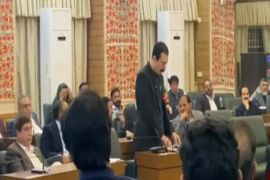Reports indicate that the Indian Armed Forces (IAF, Army, and other branches) have seen increasing politicization and religious influence, raising concerns about the military’s neutrality and secular character.
Analysts and human rights organizations highlight the growing “saffronization” of the forces under Prime Minister Narendra Modi’s administration, linking military actions, symbols, and recruitment practices to Hindu nationalist agendas.
Religious Symbolism in Military Spaces
In January 2025, the Army Chief’s lounge in South Block, New Delhi, replaced a historic 1971 war painting with “Karam Kshetra”, depicting Hindu mythological figures alongside modern military assets.
Similarly, in December 2024, the Fire and Fury Corps unveiled a statue of 17th-century Hindu king Shivaji near Pangong Tso in Ladakh, accompanied by a saffron flag, signaling the assertion of Hindu identity in a sensitive strategic area.
Religious Rituals and Political Statements
Senior military officials, including the Army Chief, have participated publicly in Hindu rituals. On National Unity Day 2025, the Army Chief received a tilak and garland while in uniform.
Other visits, such as the COAS’s May 2025 trip to Hindu spiritual leader Rambhadracharya’s ashram, where he received religious initiation, have raised concerns about blurred lines between institutional duty and religious allegiance.
Politicization of Military Operations
Military operations have increasingly adopted Hindu religious names, such as “Sindoor” and “Mahadev”, reflecting ideological branding.
Statements by senior officials echoing BJP’s hardline rhetoric, including threats to Pakistan, suggest a shift toward aligning military discourse with nationalist political agendas.
Recruitment and Institutional Influence
The Agnipath scheme, initiated in 2022, and Sainik Schools are reportedly shaping future officers with influence from Hindu nationalist networks such as the RSS and affiliates of the Ram Mandir movement. Analysts warn this could embed ideological leanings in the military’s leadership pipeline.
Impact on Minority Officers
Reports indicate that minority officers, including Sikhs, Muslims, and Christians, face coercion to participate in Hindu rituals, professional insecurity, and social exclusion.
The case of Lt. Samuel Kamalesan, a Christian officer dismissed in 2025 for refusing to follow such practices, underscores growing concerns over institutional discrimination.
Human Rights Concerns
A 2025 Human Rights Watch report documents over 520 custodial deaths and extrajudicial killings in military custody, with some linked to ideological shifts and majoritarian policies.
Conclusion
Experts and analysts warn that these developments threaten the Indian Armed Forces’ secular, neutral character, cohesion, professionalism, and public legitimacy.
Critics argue that the military’s increasing alignment with Hindu nationalist politics risks turning it into a partisan force, compromising one of the country’s most critical institutions.







